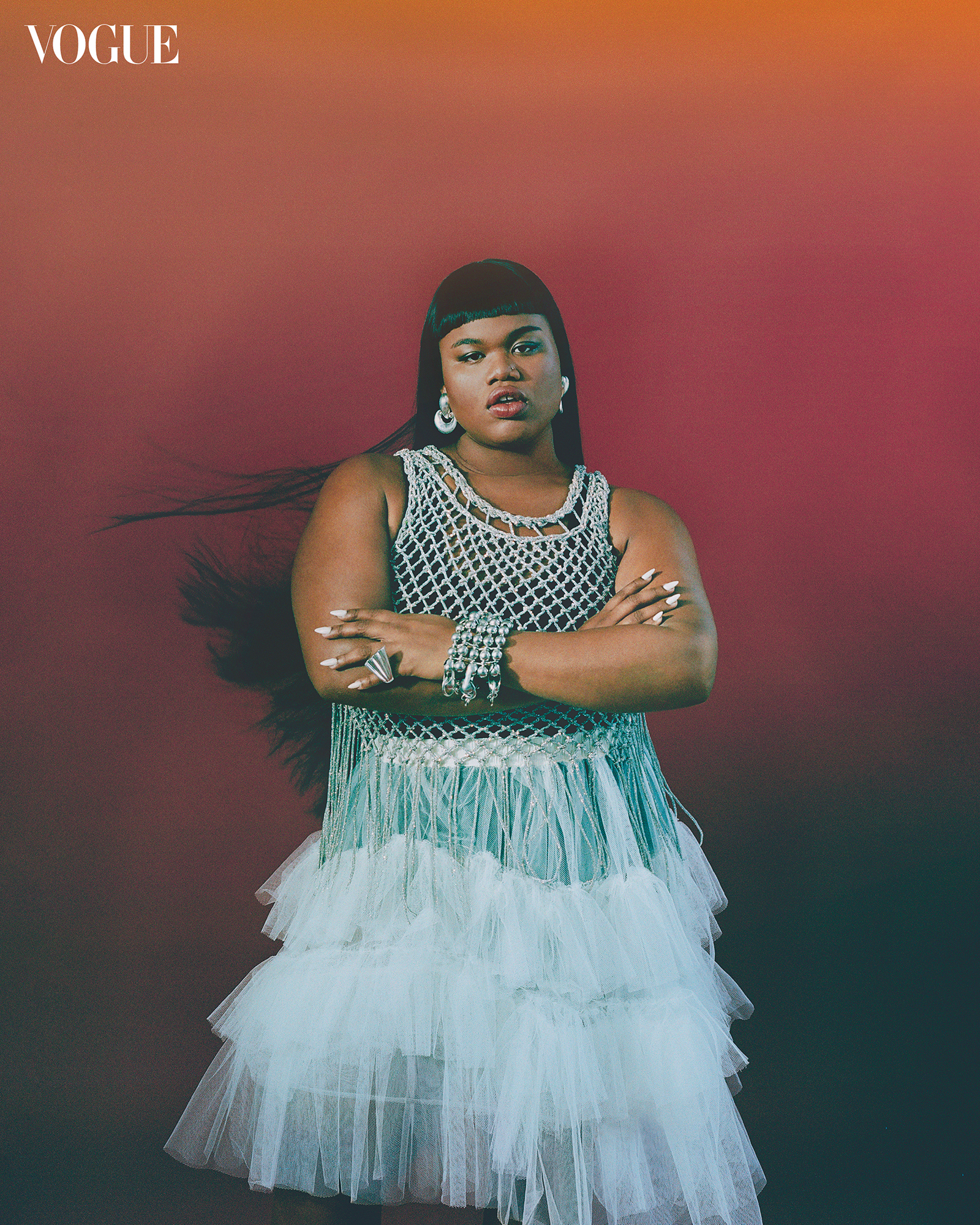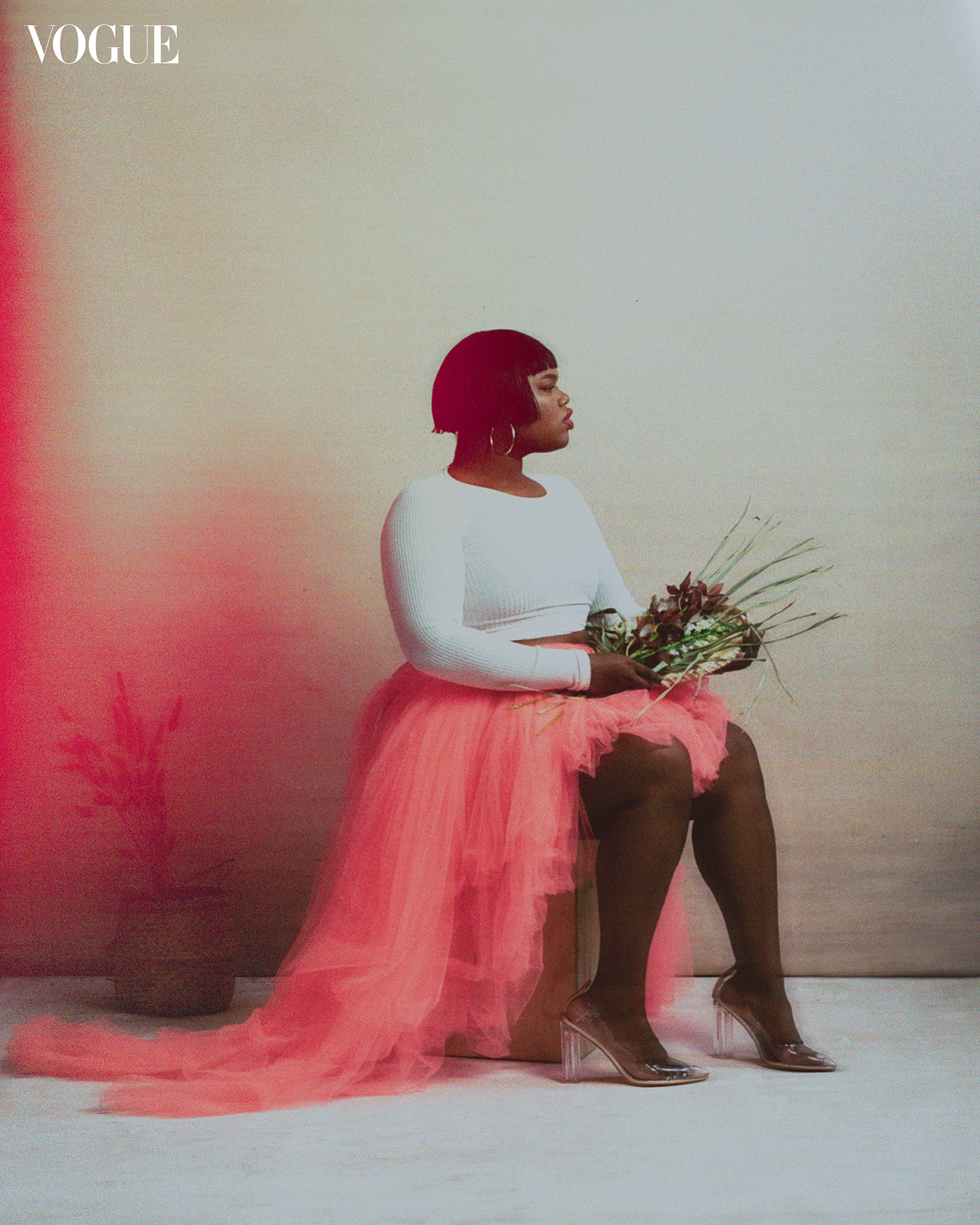JW ANDERSON top, FERRAGAMO skirt, PATRICIA VON MUSULIN earrings, cuffs and rings.
Model, activist, and all-around creative Jari Jones has always lived her life in a spectrum. Like multiple shades of the same color, flowing seamlessly to form her current identity. One that is a blend of what she was born with and what she has chosen to be. As a queer, mixed-race child, Jari didn’t know where to fit in. At 32, she is breaking barriers and opening doors for the communities she represents, one creative project at a time. She’s been the face of brands like Calvin Klein and Maybelline, promoting inclusivity and diversity. And she’s just getting started.
Jones is a confluence of identities. She’s African-American, and Filipino. She’s transgender, and she’s not the usual size zero. Characteristics wouldn’t make the cut for being a model just two decades prior. But Jones doesn’t let any societal norm hold her back. She embraces every part of her and eagerly shares them all with the world. “What I really want to do is expand beauty and size inclusion in fashion,” she opined. “I want to see more representation that looks like me or is more marginalized than me. I want to bring art together into a world where we can bridge the gap between the Black and Asian communities.”

But it wasn’t always like this for Jones. While she was lucky to have always had a supportive family and group of friends, it took some time for her to be able to fully embrace her identity. “I wasn’t black enough for the black folks. I wasn’t Filipino enough for the Filipino folks. I definitely wasn’t white. I was always trying to prove myself in the ways young children do. I want to show you that I’m proud—I want to show you that I have this in me.”
It was the love and support of those around her that really turned it around. Growing up with her mom’s side of the family who were mostly African-American creatives, Jones was exposed to the importance of self-expression. While her dad wasn’t a huge presence in her life, she made sure to cultivate a relationship with the rest of his family, opening up her connection to her Filipino side.
“My family always knew I was going to be a star. I would put on fashion shows and concerts,” she recalled, adding that she’s been a theater kid since she was 13. “My dad’s side is very musical. So they were also very embracing of that. My mom’s side, they’re all from a dance background or just arts-in-general, whether spoken word and poetry or writing. So my creative pursuits were definitely embraced.”
It took some time, but now, Jones knows that there’s no need to choose one side or to keep herself in one box forever. Her two families and two identities helped her see that it’s perfectly fine to fit into more than one box and create your own—changing it as needed. She has the freedom to create her unique identity, shaped by her ethnicity, upbringing, and the experiences that brought her to where she is today.
She replicates the kind of support and love she constantly received in the communities she builds. She recalled how even when her decision to transition took a while to be fully accepted, she was never without the love and support of her family. “To make it a bit symbolic, I had arms around me all throughout. It was definitely a slow hug. And you know, we eventually got there, but I did have it. I was never worried that I was going to be shunned or that I was going to be houseless, or that I was going to be taken away, or had to live a new life. Even my [Filipino] grandmother, who is so proud of lineage, told me, ‘You’re always going to be you. You’re part of me; you’re my family.’”
For Jones, it would be selfish not to share that. “I have definitely integrated my chosen family into lots of my own. Everybody knows that I have a million kids, a million sisters, and a million brothers.” Growing up in a big household full of love and support, Jones only wishes for her communities—her chosen families—to grow in more love and acceptance than she herself received.

True beauty
“Beauty has been such an interesting word and topic for me just because I wasn’t right for so long,” Jones said earnestly. For the longest time, beauty has been defined by Eurocentric features and being skinny. Jones’ piercing almond eyes, paired with features often associated with African-Americans, gave her a look that did not fit the standard. It did, however, make her more of a standout. Jari Jones became a model at the right time. When people started to appreciate beauty beyond the cookie-cutter look. “Releasing those standards and releasing this idea that there is a real beauty and then there’s fashion beauty, and I can be encompassing of it all, right?”
For Jones, a lot of it had to do with reconnecting with her roots. “Reconnecting with being Filipino, being black. Not what society has put out about being either but more so, about going back to tradition and going back to what we’ve seen beautiful,” she said. “I connect so much more with those than I do with American or Western versions of what that is. So now, beauty for me comes from where the bases are. I see beauty in indigeneity.” On a recent trip to South Africa, Jones had the opportunity to immerse herself and look at more diverse forms of beauty directly in the face. “This is where the core of it is; this is where it started. How can we get back to that without it being a competition or comparison but more so of opening the space back up to where it started?”
She admits that her favorite thing in her makeup kit is a liner – something she can both use for her eyes and lips. “It’s through these two things on my face that I have either been picked on for or have been exoticized for, or have been just othered for.” Rather than recoiling and hiding them, Jones added that she loves bringing them out and making them pop. Now, she often gets asked where she gets her lips done. “They’re natural,” she said confidently.
Someone as beautiful as Jones admits that she’s still constantly working on her inner self and prioritizing self-love. “But I think I feel the most beautiful when I’m creating. It might be a little bit vague, but it’s as a model, a photographer when I’m painting or writing something, that’s when I feel most beautiful,” she said. “I think it’s because the beauty doesn’t necessarily have to do with my physical appearance and more so about what’s in the air and coming out.”


Creating her own definitions
“So much of my life is of being in between lines—on a spectrum—and not necessarily being on one end to the other,” Jones said. For her, life is best lived embracing those blurred lines, to be able to embrace moments where things are happening simultaneously. “That’s this beautiful purgatory, this liminal space that allows me to not have to run to one side or the other that I can just, you know, exist and be right in the middle.”
Jari Jones is who she says she is. There’s something admirable about how self-aware and flexible she is with life and how she adjusts to the ebbs and flows of its fluidity. She advises people to stop seeking external validation. “I did for so much of my life, and now I am so proud to be who I am and don’t need that from anybody else. If I do get external validation, it’s like whipped cream or a cherry on top—it’s the fixings, right? I know who I am, I know where I sit, and that’s how I move through life.”
In a spectrum of hues, Jones says she is closest to orange, and it’s a color always seen in her art. “Orange is sharp and eye-catching. It’s beautiful, but it never feels like it’s telling you to stay away, but it’s always telling you that it’s passionate,” she said. “Orange can also feel delicate, but it’s more grounded and hefty.”
Through her art and advocacy, Jari Jones is a beacon of hope for those who have felt unseen and unheard. In a world where labels and categories are all too often used to separate and divide, she reminds us that there is beauty in diversity and strength in unity. By embracing her own unique identity and encouraging others to do the same, she has shown us what it truly means to be free. And in doing so, she has inspired a new generation of creatives and change-makers to follow in her footsteps.
